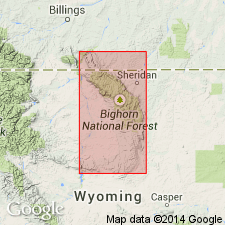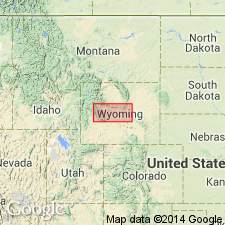
- Usage in publication:
-
- Lander sandstone member
- Modifications:
-
- Original reference
- Biostratigraphic dating
- Dominant lithology:
-
- Sandstone
- AAPG geologic province:
-
- Wind River basin
Summary:
Pg. 196-213. [Lander sandstone member of Bighorn dolomite.] Bighorn formation of northeastern slope of Wind River Mountains, Wyoming, consists of: (1) a very fossiliferous, thin basal sandstone member, 1 to 4 feet thick (here named Lander sandstone, from exposures about 10 miles southwest of Lander, western Wyoming); (2) a massive dolomite member about 300 feet thick in northwestern part of range and less than 150 feet in southeastern part of range; and (3) an upper dolomite member, about 25 feet thick (the Leigh dolomite of Blackwelder). [Lists and discusses fauna of Lander sandstone (135 species) and concludes that it is of Richmond age and a southern extension of a widespread Arctic fauna of that age.] "Available evidence indicates Lander sandstone is to be correlated with basal sandstone member of [typical] Bighorn formation of Bighorn Mountains." [He therefore concludes all of Bighorn dolomite is of Richmond age.]
Source: US geologic names lexicon (USGS Bull. 896, p. 1143).

- Usage in publication:
-
- Lander Sandstone* Member
- Modifications:
-
- Overview
- AAPG geologic province:
-
- Wind River basin
Summary:
Bighorn Dolomite forms cliffs. Bighorn divisible into basal sandstone, the Lander Sandstone Member; middle massive dolomite; and an upper thin-bedded dolomite, the Leigh Dolomite Member. The Lander occurs locally along the east flank of the Wind River Range where it is a lenticular gray to tan, partly red, fine- to coarse-grained sandstone less than 5 ft thick. Fragments of the unconformably underlying Gallatin Limestone are commonly incorporated in the lower part of the Lander. The middle member is uniform, resistant, cliff-forming, buff to gray granular dolomite 230 ft thick in central and northern Wind River Range to 15 in southern part of basin, that has rough pitted surface. The Leigh is a white, gray, pink, thin-bedded to platy dolomite 85 ft thick in northwest end of Wind River Range; thins south owing to erosional unconformity at top at contact with Darby Formation. Formation is fossiliferous: poorly preserved corals, mollusks, crinoids. Most of Bighorn considered Late Ordovician but Lander may be Middle Ordovician. Lander is a transgressive marine deposit whose source is not known. The main body of the Bighorn was deposited in a warm shallow sea. Cross sections. Isopach map shows extent of Bighorn in Wind River basin and adjacent Sublette Co, Greater Green River basin, and Hot Springs and Washakie Cos, Bighorn basin.
Source: GNU records (USGS DDS-6; Denver GNULEX).
For more information, please contact Nancy Stamm, Geologic Names Committee Secretary.
Asterisk (*) indicates published by U.S. Geological Survey authors.
"No current usage" (†) implies that a name has been abandoned or has fallen into disuse. Former usage and, if known, replacement name given in parentheses ( ).
Slash (/) indicates name conflicts with nomenclatural guidelines (CSN, 1933; ACSN, 1961, 1970; NACSN, 1983, 2005, 2021). May be explained within brackets ([ ]).

